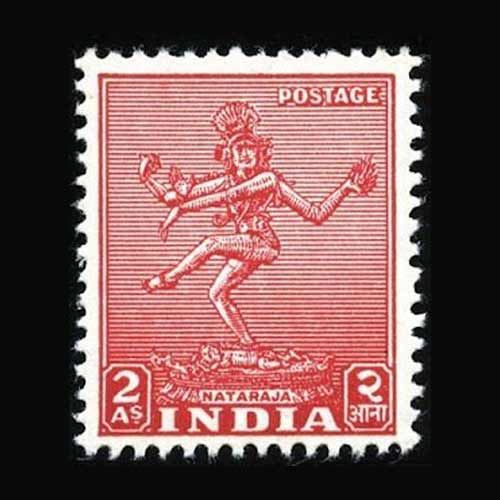Fascinating Archaeological Facts on Postage Stamps -5
2025-04-17 Thu
The fifth stamp in the Archaeological and Historical Monuments Definitive series, 1949, is of Nataraja or the Cosmic Dancer Shiva. With a face value of 2 Annas, Nataraja is one of the dancing forms of Lord Shiva, commonly associated with the Chola Bronze sculptures. The iconography was developed during the Chola period between the 9th and 10th centuries.This Nataraja on the stamp is shown in an AnandaTandav pose. The sculpture has four hands representing the cardinal directions. He is posing on a lotus pedestal with his left foot rising elegantly and the right foot placed on the Apasmara Purusha, a demon representing ignorance.
Nataraja Shiva is holding Agni (fire) in his left hand, while his front hand is in the dandahasta mudra. His front right hand has a snake wrapped in it, and that hand is in the abhaya mudra. His backhand is holding a damru.
A 2-metre-high Nataraja bronze was unveiled in 2004 at the European Center for Research in Particle Physics (CERN) in Geneva.
The Nataraja by the Cholas continues to be a popular icon in South Asian art and iconography. The sculpture on the stamp is originally from Tiruvalangadu - housed in the Government Museum, Chennai (TamilNadu ).
Latest News
-
Malwa Sultan Mahmud Shah Silver Coins
2025-09-11 ThuMalwa Sultan Mahmud Shah minted silver coins in round and square flans. <br><br> For round coins,...
-
Malwa Sultan Mahmud Shah Billon coin
2025-08-26 TueMalwa Sultan Mahmud Shah's billon coins followed three weight standards: 100 rati, 96 rati, and 80 r...
-
Fascinating Archaeological Facts on Postage Stamps - 91
2025-08-23 SatRhinoceros is one of the oldest land mammal species existing in India. There are five species of rhi...
-
Fascinating Archaeological Facts on Postage Stamps - 90
2025-08-23 SatUthiramerur, a Village in Kanchipuram, Tamil Nadu, is notable for its Temple inscriptions that descr...
-
Fascinating Archaeological Facts on Postage Stamps - 89
2025-08-21 ThuThe term “millet” is derived from the Latin word “milum,” which translates to grain. millets...

